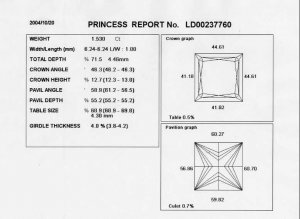asblackrock
Shiny_Rock
- Joined
- Oct 16, 2004
- Messages
- 201
If you know the Pavilion depth, the Crown depth and the Table of a diamond (all given as a % of average diameter), the “all so important “ Pavilion Angle and Crown angle can be calculated easily.
PAVILION ANGLE:
1. Enter the Pavilion depth into your calculator.
2. Divide this by 50.
3. There is a button on many calculators labelled “Tan –1”, or it may be written in small writing above the “Tan” button. Press the “Tan –1” button (or if it is written above the “Tan” button, press the shift button, then the “Tan” button). This is the exact pavilion angle in degrees.
Eg. Pavilion depth = 43.1
43.1/50 = 0.862
“Tan –1” 0.862 = 40.76. This is the exact pavilion angle in degrees
CROWN ANGLE:
1. Divide the Table by 100
2.Subtract this from 1
3. Multiply this by 50
4. Store this figure
5. Divide the Crown depth by the above figure
6. Press the “Tan-1” key. This is the exact crown angle in degrees
Eg. Table = 53 Crown depth=16.2
53/100 = 0.53
1-0.53 = 0.47
50x0.47 = 23.5
16.2/23.5 = 0.68936
“Tan –1” = 34.58. This is the exact crown angle in degrees
I hope this is helpful to forum readers.
Note: This formula only works for round brilliant cut diamonds with no culet (ie pointed). If a culet is present, use the crown angle formula to work out the pavilion angle, plugging in culet rather than table (if you flip a stone upside down, the culet becomes a mini "table").
PAVILION ANGLE:
1. Enter the Pavilion depth into your calculator.
2. Divide this by 50.
3. There is a button on many calculators labelled “Tan –1”, or it may be written in small writing above the “Tan” button. Press the “Tan –1” button (or if it is written above the “Tan” button, press the shift button, then the “Tan” button). This is the exact pavilion angle in degrees.
Eg. Pavilion depth = 43.1
43.1/50 = 0.862
“Tan –1” 0.862 = 40.76. This is the exact pavilion angle in degrees
CROWN ANGLE:
1. Divide the Table by 100
2.Subtract this from 1
3. Multiply this by 50
4. Store this figure
5. Divide the Crown depth by the above figure
6. Press the “Tan-1” key. This is the exact crown angle in degrees
Eg. Table = 53 Crown depth=16.2
53/100 = 0.53
1-0.53 = 0.47
50x0.47 = 23.5
16.2/23.5 = 0.68936
“Tan –1” = 34.58. This is the exact crown angle in degrees
I hope this is helpful to forum readers.
Note: This formula only works for round brilliant cut diamonds with no culet (ie pointed). If a culet is present, use the crown angle formula to work out the pavilion angle, plugging in culet rather than table (if you flip a stone upside down, the culet becomes a mini "table").









300x240.png)